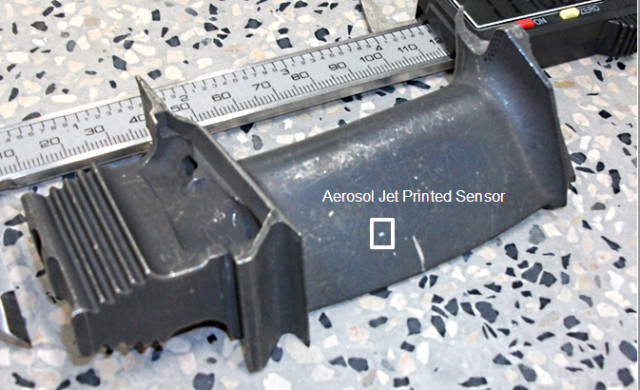3D Printed Sensors Monitor Jet Engine Compressor Blades

3D printed sensors are nearly invisible on the jet engine part. Courtesy of WCPC.
November 23, 2015
Additive manufacturing (AM) has long been of interest to aerospace companies for its ability to reduce the weight of vital parts, resulting in an overall reduced weight for an aircraft and increased fuel efficiency. As the technology has improved, AM has been utilized for other aerospace applications, including printing metal blades for jet engines, and even entire jet engines.
The newest application for AM in aerospace is the creation of in situ printed electronics to help monitor aerospace components. Research performed at the Welsh Centre for Printing and Coating (WCPC), part of Swansea University, used Optomec’s aerosol jet process to print strain and optical creep sensors directly onto jet engine compressor blades.
 3D printed sensors are nearly invisible on the jet engine part. Courtesy of WCPC.
3D printed sensors are nearly invisible on the jet engine part. Courtesy of WCPC.The printed sensors monitor the condition of the blades in real time, offering the potential for higher running speeds and increased fuel efficiency. Additionally, the sensors could reduce maintenance time by automatically generating hard data about the blades that would otherwise require additional time in the maintenance crews.
Optomec’s aerosol jet process operates by spraying a layer of conductive nano-silver ink that is directed by a flow guidance deposition head. While it may sound as accurate as spraying water out of a plant mister, the nozzle that directs the material flow is able to focus the stream to within 10 µm. Following deposition, a thermal post-treatment sets the material in place.
Along with being nearly invisible to the naked eye, the nano-silver ink is also heat resistant up to 482°F. WCPC researcher are currently at work to improve that number by developing a new nano-platinum ink capable of operating at up to 2192°F. The ability to continue sensor duties at higher temperatures is critical if the sensors are to have practical applications.
Previous experiments with Optomec’s process have printed electronics directly into UAV parts, and this is unlikely to be the last time researchers find new ways to use 3D printed sensors. Below you’ll find a video that discusses the value of printed sensors.
Source: WCPC
Subscribe to our FREE magazine, FREE email newsletters or both!
About the Author
John NewmanJohn Newman is a Digital Engineering contributor who focuses on 3D printing. Contact him via [email protected] and read his posts on Rapid Ready Technology.
Follow DE





